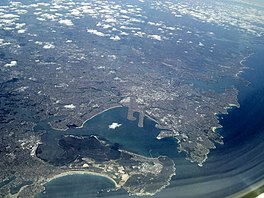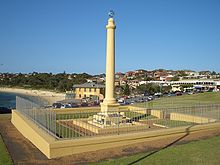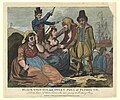Botany Bay
| Botany Bay | ||
|---|---|---|
| Kamay/Gamay, Sting Ray Harbour[1] | ||
 Aerial photo of Sydney showing Botany Bay in the foreground. The two protrusions into the bay are runways of Primary inflows Georges River, Cooks River | | |
| Primary outflows | Tasman Sea | |
| Catchment area | 54.9 km2 (21.2 sq mi) | |
| Max. length | 10 km (6.2 mi) | |
| Surface area | 39.6 km2 (15.3 sq mi) | |
| Average depth | 11.4 m (37 ft) | |
| Water volume | 440,815,800 m3 (1.556726×1010 cu ft) | |
| Website | NSW Environment & Heritage webpage | |
Botany Bay (
The total catchment area of the bay is approximately 55 km2 (21 sq mi). Despite its relative shallowness, the bay now serves as greater metropolitan Sydney's main cargo seaport, located at Port Botany, with facilities managed by Sydney Ports Corporation. Two runways of Sydney Airport extend into the bay, as do some port facilities. Kamay Botany Bay National Park is located on the northern and southern headlands of the bay. The area surrounding the bay is generally managed by Transport for NSW.
The land adjacent to Botany Bay was settled for many thousands of years by the
History
Aboriginal prehistory
Archaeological evidence from the shores of Botany Bay has yielded evidence of an Aboriginal settlement dating back 5,000 years. The Aboriginal people of Sydney were the Eora, the Dharawal and the Dharug people who comprised at least 28 known clans with traditional boundaries. The clans of the Botany Bay area were the Gweagal who occupied the south shore and the Gameygal on the north shore. It is possible that the Bidjigal clan lived between the Cooks River and the Georges River, but the evidence for this is unclear.[5][6]
European history and later

Eighteen years later, Governor
The area was studded with enormously strong trees. When the convicts tried to cut them down, their tools broke and the tree trunks had to be blasted out of the ground with gunpowder. The primitive huts built for the officers and officials quickly collapsed in rainstorms. Crucially, Phillip worried that his fledgling colony was exposed to attack from
On the morning of 24 January, the French exploratory expedition of Jean-François de Galaup, comte de Lapérouse was seen outside Botany Bay. On 26 January, the Supply left the bay to move up to Port Jackson and anchor in Sydney Cove. On the afternoon of 26 January, the remaining ships of First Fleet arrived at Sydney Cove. In 1789, Captain John Hunter surveyed Botany Bay after returning from the Cape of Good Hope, trading for grain. The good supply of fresh water in the area led to the expansion of its population in the 19th century.
The western shore of Botany Bay remained in its virgin state for almost fifty years after the initial settlement of Sydney Town. Land access to the area was difficult until a route from the west was established via Canterbury. As this route developed it became known as Illawarra Road, which is still one of the main access routes to the south-eastern suburbs of Sydney. The land nearer to this crossing of Cooks River was cleared and settled quite early in the infancy of the new colony.
Landmarks

Sydney Airport, Australia's busiest airport, sits on the northwestern side of Botany Bay. Some of its runways go out into the bay. After World War II the mouth of the Cooks River was moved two kilometres west to make way for the airport extension. Land was reclaimed from the bay to extend its first north–south runway and to build a second, parallel, runway.
The first container terminal at Port Botany, east of the airport, was completed during the 1970s and is the largest
The land around the headlands of the bay is protected by the NSW National Parks & Wildlife Service as Kamay Botany Bay National Park. On the northern side of the mouth of the bay is the historic site of La Perouse, and to the south is Kurnell. Despite its relative isolation, the southern shore of the bay is dominated by an unusual mixture of pristine national park and heavy industrial use that includes Sydney Desalination Plant, the Caltex Fuel Terminal, sewer treatment, and historical sand mining facilities.[13] On the southern side of the bay a section of water has been fenced off under the authority of the NSW National Parks & Wildlife Service at Towra Point for environmental conservation purposes.
The western shores of the bay feature many popular swimming beaches including Lady Robinsons Beach and are highly urbanised.
There are also a lot of bunkers around Botany Bay. The bunkers were built by the military during World War II and still remain.[14]
Marine life
Botany Bay has a diverse marine population, and the area around its entrance is a popular area for scuba diving. In 2008, the Botany Bay Watch Project began with volunteers assisting to monitor and protect the Bay Catchment and its unique marine life.[15]
The world's largest population of
In popular culture
- Despite the move to Pete St. John.
- A song named "Botany Bay" has been performed as a folk and music hall song since the 1890s, based on older tunes. It also refers to the penal colony.
- A song entitled "The Shores of Botany Bay" was written by Brian Warfield and recorded by The Wolfe Tones in the early 1970s. This satirical song deals with a group of Irishmen volunteering for the transportation process in the hopes of finding wealth in Australia.
- A song titled "Bound for Botany Bay" is featured on Irish singer-songwriter and guitarist John Doyle's album Shadow and Light.
- In the 1941 historical novel Botany Bay by Charles Nordhoff and James Norman Hall, the protagonist, after various adventures and misadventures in England, gets transported to Botany Bay. A movie based on the book starring Alan Ladd and James Mason was shot in 1953.
- The song "Jim Jones at Botany Bay" (aka "Jim Jones") is about a prisoner who is going to Botany Bay. The song has been recorded several times, including a well-known version by Bob Dylan, and sung by Jennifer Jason Leigh in The Hateful Eight.[17]
- SS Botany Bay was the name of the spaceship on which Khan Noonien Singh and his followers escaped from Earth in Star Trek: The Original Series and Star Trek II: The Wrath of Khan.
- In the play and musical Sweeney Todd: The Demon Barber of Fleet Street, Benjamin Barker, the man who would become Sweeney Todd, was transported to Botany Bay for life on a false charge by Judge Turpin.
- In the Runescape, Botany Bay is the name of a location in-game where players can view other players' accounts being penalized for using "bots", computer macros, to cheat.[18][19]
- The 2015 7-part British TV series Banished was a dramatisation of the first few weeks of the penal colony.
Gallery
-
TheKurnell
-
The mouth of Botany Bay from the air
-
Botany Bay, view fromKurnell
-
Black-eyed Sue and Sweet Poll of Plymouth, England, mourning their lovers who are soon to be transported to Botany Bay, 1792
-
Bicentennial Monument at Brighton-Le-Sands
-
Sydney Airport runway near Botany Bay beach
-
skylineviewed from Botany Bay
Notes
- ^ The strikethrough is in the Cook's original, reflecting a change of mind sometime after leaving the Bay in 1770.
References
Citations
- ^ corporateName=National Museum of Australia; address=Lawson Crescent, Acton Peninsula. "National Museum of Australia - Settling on a name". www.nma.gov.au. Retrieved 26 March 2023.
{{cite web}}: CS1 maint: multiple names: authors list (link) - ^ .
- ^ "Meeting at Kamay". Teaching Resources. NSW Government (Department of Education). Retrieved 11 March 2021.
- ^ "Kamay (Botany Bay)". Endeavour Voyage. National Museum of Australia. Retrieved 11 March 2021.
- ISBN 0-908272-45-6.
- ISBN 9781742231167.
- ^ Cook, James; Hawkesworth, John (1773). "Entrance of Endeavour River in New South Wales. Botany Bay in New South Wales" (Map). David Rumsey Historical Map Collection. State Library of Queensland. Retrieved 7 September 2012.
- ^ Wales, Geographical Name Board of New South. "Extract – Geographical Names Board of NSW". gnb.nsw.gov.au. Archived from the original on 7 November 2016. Retrieved 7 November 2016.
- ^ a b Beaglehole (ed.) 1968, p. ccix
- ^ Parker 2009, p.113
- Museum of Australian Democracy. Retrieved 24 November 2013.
- ^ Governor Phillip to Lord Sydney, 15 May 1788, cited in Britten (ed.) 1978, pp. 121–123
- ^ "Kurnell Peninsula: a guide to the plants, animals, ecology and landscapes". Sydney Metropolitan Catchment Management Authority. 2010. Retrieved 7 January 2013.[permanent dead link]
- ^ "Old & Abandoned Australia Public Group | Facebook". mbasic.facebook.com. Retrieved 28 September 2020.
- ^ "Botany Bay Watch Project". Botanybaywatch.com.au. Archived from the original on 18 July 2008.
- ^ "Marine Blue Groper". Botanybaywatch.com.au. Archived from the original on 19 July 2008.
- Sydney Morning Herald. Retrieved 6 September 2018.
- Jagex Ltd.26 September 2012. Retrieved 6 September 2018.
- Future US, Inc.Retrieved 6 September 2018.
Works cited
- OCLC 223185477.
Further reading
- Britton, Alex R., ed. (1978). Historical records of New South Wales. Vol. 1, part 2. Phillip, 1783–1792. Lansdown Slattery & Co. p. 56. OCLC 219911274.
- Forster, George (2008). Allgemeines historisches Taschenbuch, oder, Abriss der merkwuridgsten neuen Welt Begebenheiten enthaltend fur 1787 [Neuholland und die brittische Colonie in Botany-Bay/New Holland and the British colony at Botany Bay] (in German). Robert J. King, translator. Canberra: National Library of Australia.
- ISBN 2-914777-30-2. Archived from the originalon 25 November 2006. Retrieved 24 May 2011.
- . Falkirk: T. Johnston. 1798.
External links
- "Georges River catchment" (map). Office of Environment and Heritage. Government of New South Wales.
- NSW Environment & Heritage webpage
- Irish Examiner article concerning penal colony
- Joanne Sippel (2013). "Booralee fishing town". Dictionary of Sydney. Dictionary of Sydney Trust. Retrieved 6 October 2015.








